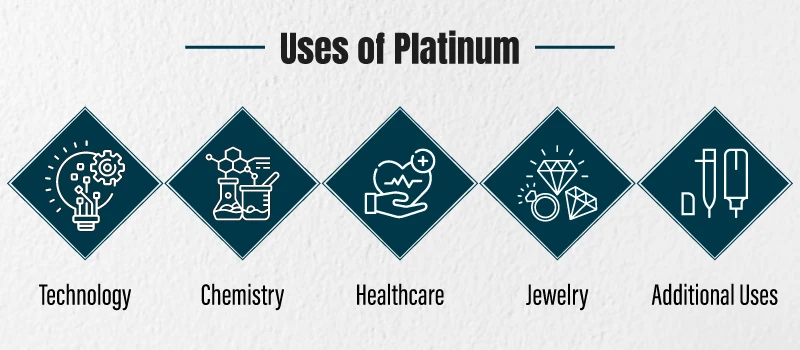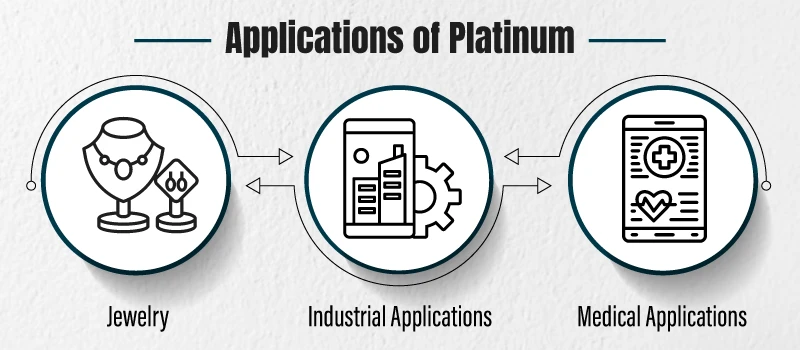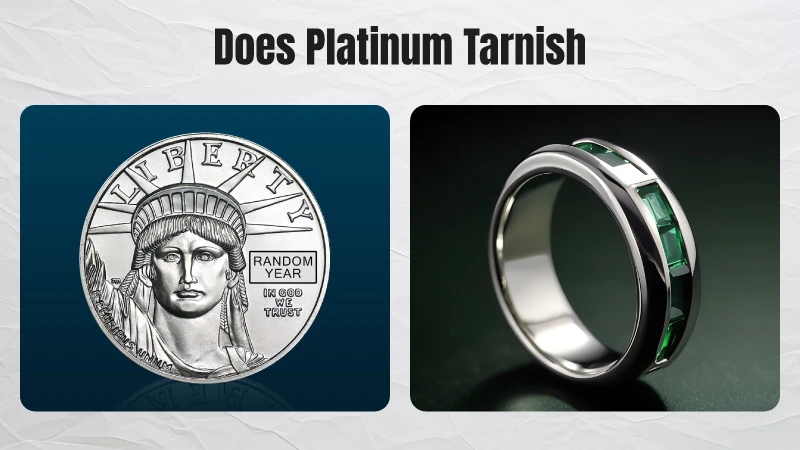First, the positive news. If you currently own platinum bullion and jewelry, you are aware that, in comparison to other precious metals, platinum requires extremely little maintenance. There are still a few people who wonder, ” Does platinum tarnish?”; the answer is no. There are essential factors to keeping its shine timeless.
Does Platinum Tarnish
Platinum has established a reputation as a sought-after and precious metal thanks to its alluring luster and wide range of applications. Its unique attributes have elevated it to the status of a symbol of grace and elegance, frequently linked to high-end jewelry, sophisticated manufacturing techniques, and cutting-edge technologies. We get asked all the time if platinum tarnishes like other metals, and to answer that, it does not. Platinum has a well-deserved reputation as a popular and versatile metal because of its distinctive qualities and importance in many different industries.
What is Tarnishing
Many precious metals undergo a process called tarnishing that results in them losing their initial shine and taking on a dull, tarnished appearance. Generally, tiny layers of tarnish grow on the surface of metals as a result of their reaction with atmospheric gases or chemicals such as sulfur compounds. Common metals that tarnish with time include brass, copper, and silver.
Uses and Applications of Platinum

Uses
The platinum group metal (PGM) has a variety of uses, such as:
-
Technology: Computer hard drives, optical fibers, thermocouples, and electrical connections all require platinum. Additionally, it was employed to coat the platters of hard disk drives, which made possible the late 20th-century revolution in digital data storage. -
Chemistry: Silicon, benzene, and nitric acid are all produced in the chemical industry using platinum as a catalyst. Additionally, it’s employed in the production of petrochemical feed stocks, which serve as the starting point for polyester fibers, synthetic rubber, and plastics. -
Healthcare: Because platinum is hypoallergenic, it is utilized in dentistry and pacemakers. Certain tumors can also be treated with platinum compounds as chemotherapy medications. -
Jewelry: Because platinum is sturdy and long-lasting, and because diamonds look better against it, it’s utilized in high-end jewelry and timepieces. -
Additional Uses: Additionally, platinum is utilized in platinum resistance thermometers, turbine blades, spark plugs, laboratory apparatus, and catalytic converters.
Applications

Despite only producing 192 tons of metal annually, platinum is a common metal that is used in many everyday products.
-
Jewelry: About 40% of the demand is met by the jewelry sector, which uses it most extensively in the alloy used to manufacture white gold. Over 40% of wedding bands sold in the US are thought to contain some platinum. The biggest markets for platinum jewelry are the United States, China, Japan, and India. -
Industrial Applications:Platinum is perfect as a catalyst in chemical reactions because of its resistance to corrosion and stability at high temperatures. Without changing chemically in the process, catalysts quicken chemical reactions.
Approximately 37% of the metal’s overall demand in this industry is satisfied by platinum’s primary use in automotive catalytic converters. By starting reactions that transform 90% of hydrocarbons (carbon monoxide and nitrogen oxides) into other, less hazardous molecules, catalytic converters lower the amount of hazardous substances found in exhaust emissions.
Additionally, gasoline and nitric acid are catalyzed by platinum, raising the fuel’s octane values. In the electronics sector, alloys are used to create magnetic disks for computer hard drives and switch contacts in automobile controls, while platinum crucibles are used to create semiconductor crystals for lasers.
-
Medical Applications: Platinum is in greater demand from the medical sector due to its dual uses: as an anti-cancer medicine (such as carboplatin and cisplatin) and for its conductive qualities in pacemaker electrodes, auditory implants, and retinal implants.
Here is a list of just a few of the numerous uses for platinum:
- Used to create high-temperature thermocouples with rhodium
- to create flat, optically clear glass for monitors, TVs, and LCDs
- to create glass strands for fiber optics
- In alloys that are used to make the tips of spark plugs for cars and airplanes
- In place of gold in electrical connections
- In ceramic capacitor coatings used in electronic devices
- In high-temperature alloys used in missile nose cones and jet fuel nozzles
- Regarding dental implants
- Here are the reworded sentences:
- Creating top-notch flutes
- In the smoke and carbon monoxide alarms
- Producing silicones
- In razor coatings
Platinum’s Resistance to Tarnishing
Platinum’s strong resistance to corrosion and tarnishing is one of its most notable qualities. Unlike oxidation-prone metals like iron or copper, platinum shows exceptional stability in a variety of conditions. Its extraordinary resistance is ascribed to its inert nature and capacity to tolerate chemical interactions with oxygen, moisture, and sulfur compounds—common atmospheric components.
Platinum is a great material for jewelry and other items that need to be durable and have a long-lasting luster because of its resistance to tarnishing. The fact that it doesn’t need to be cleaned or polished frequently to keep its shine is one factor in its appeal in the market for luxury goods.
Conclusion
In conclusion, you must have got an answer does platinum tarnish? Platinum’s remarkable resistance to tarnishing makes it an ideal choice for those seeking long-lasting beauty in their jewelry and other valuable items. Unlike many different metals, platinum maintains its luster with minimal maintenance, offering a durable and elegant option that stands the test of time. Whether you’re investing in platinum for its aesthetic appeal or its wide range of applications, you can be confident that it will retain its value and shine for years to come.
Diversify your portfolio today with platinum bullion and jewelry at BOLD Precious Metals. We offer a wide range of coins, bars, and jewelry products, from rings to earrings at the lowest prices. Explore today!


